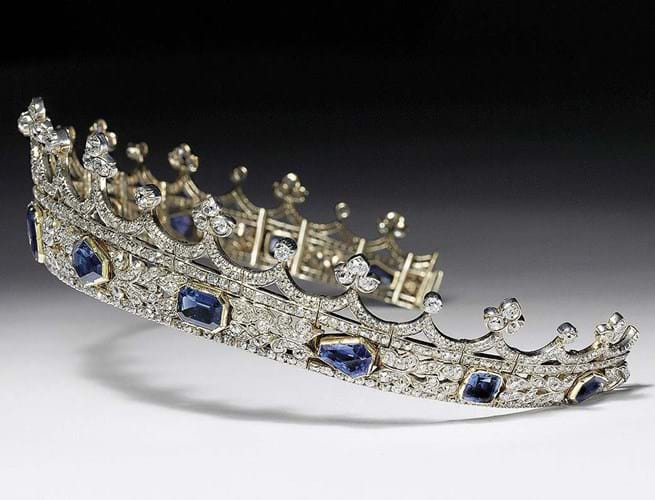
Drawings relating to one of the best-known pieces of Victorian jewellery surfaced for sale in Colchester this month.
Prince Albert’s pencil sketches for the diamond and sapphire coronet he designed for Queen Victoria in 1840 sold for £23,000 at Reeman Dansie (20% buyer’ premium) on November 9.

The coronet itself was saved from export in 2017 following its $6.5m purchase for the V&A by William and Judith Bollinger.
Image copyright: Victoria and Albert Museum London.
The history of the coronet – now on display in the Victoria and Albert Museum following its $6.5m purchase in 2017 – is well documented.
Designed by Albert in the royal couple’s wedding year to match a brooch he had given Victoria the day before they married, it was made by jeweller Joseph Kitching, partner at Kitching and Abud, using 11 Sri Lankan sapphires gifted by William IV and Queen Adelaide.
In 1842, the young Victoria wore the newly completed coronet in the first official portrait by Franz Xaver Winterhalter and in 1866 she wore it again instead of the state crown when she felt able to open Parliament for the first time since Albert’s death.
As a personal rather than a crown jewel, it passed by descent to the family of Mary, Princess Royal and Countess of Harewood.
Drawings history
The history of these two small pencil drawings is more opaque. However, at some time they were mounted on blue paper and pasted into the front of a presentation copy of The Principal Speeches and Addresses of His Royal Highness The Prince Consort (1862) given by Queen Victoria to her groom in waiting General Sir Frederick Stovin (1783-1865).
A former Napoleonic Wars soldier, Stovin served the queen from 1837 until his death and knew the royal family intimately. Victoria had inscribed the book In recollection of many happy years for our past from the great, good and well beloved Prince’s broken hearted Widow Victoria RI, Osborn Jan:28 .1863.
Albert took a very keen interest in Victoria’s jewellery and designed a number of pieces – including the turquoise and pearl ‘eagle’ brooches worn by her 12 bridesmaids. One of the queen’s diary entries from February 1843 states: “We were very busy looking over various pieces of old jewellery of mine, settling to have some reset, in order to add to my fine ‘parures’. Albert has such taste and arranges everything for me about my jewels.”
Measuring just 5 x 7cm and 5 x 6cm, these rudimentary ‘back of a fag packet’ sketches appear to be Albert’s initial designs for the coronet that he based on the Saxon Rautenkranz, his family coat of arms. They detail the choice of a Gothic revivalist style and the octagonal and calf’s head shape step-cut sapphires to be set in silver and gold.
The whereabouts of Kitching’s working drawings for the coronet are unknown so these sketches provide a very tangible link between the prince and one of Victoria’s most beloved jewels.
A photograph of the book and its sketches had reached Reeman Dansie managing director and royal memorabilia specialist James Grinter earlier this year.
He said: “I knew immediately what they were and recognised they were potentially much more valuable than the book which the vendor believed more important.
“But how do you value something like this? I put my finger in the air and said £800-1200.”
In fact, two bidders, understood to be a representative of the V&A and an international jewellery dealer, exchanged blows up to £23,000 (close to £28,000 with fees).
The dealer won the lot and then spent a further £740 to purchase the book in which they were found. Grinter had to repeat the selling price to the vendor three times before she accepted it was not a wind-up.
Bracelet rediscovery
The story of Victoria’s jewellery continues to be told in new ways.
Earlier this year, Pall Mall jewellery dealership Humphrey Butler announced the rediscovery of a bracelet from the sapphire and diamond suite. It, too, has been secured on loan for display in the William and Judith Bollinger Gallery at the V&A.
The bracelet and tiara were last on public display together at the Dorchester Hotel in 1953 when, loaned by Mary for a brief exhibition, they were shown together with a matching necklace, its current whereabouts unknown following its sale by auction in the 1970s.














